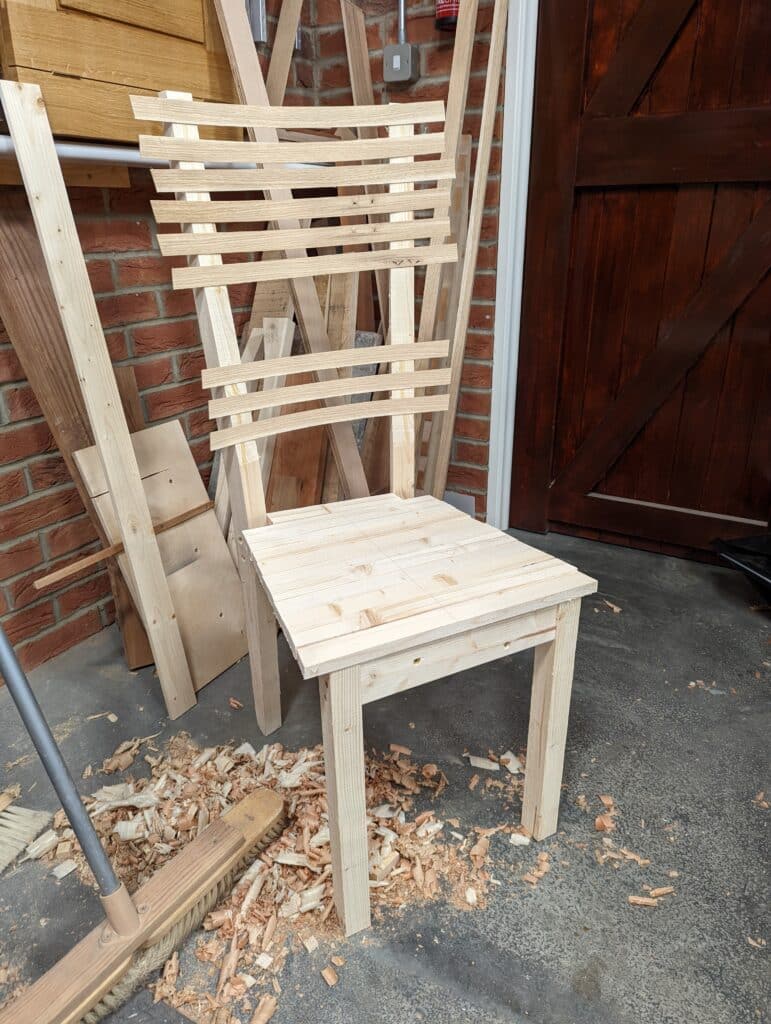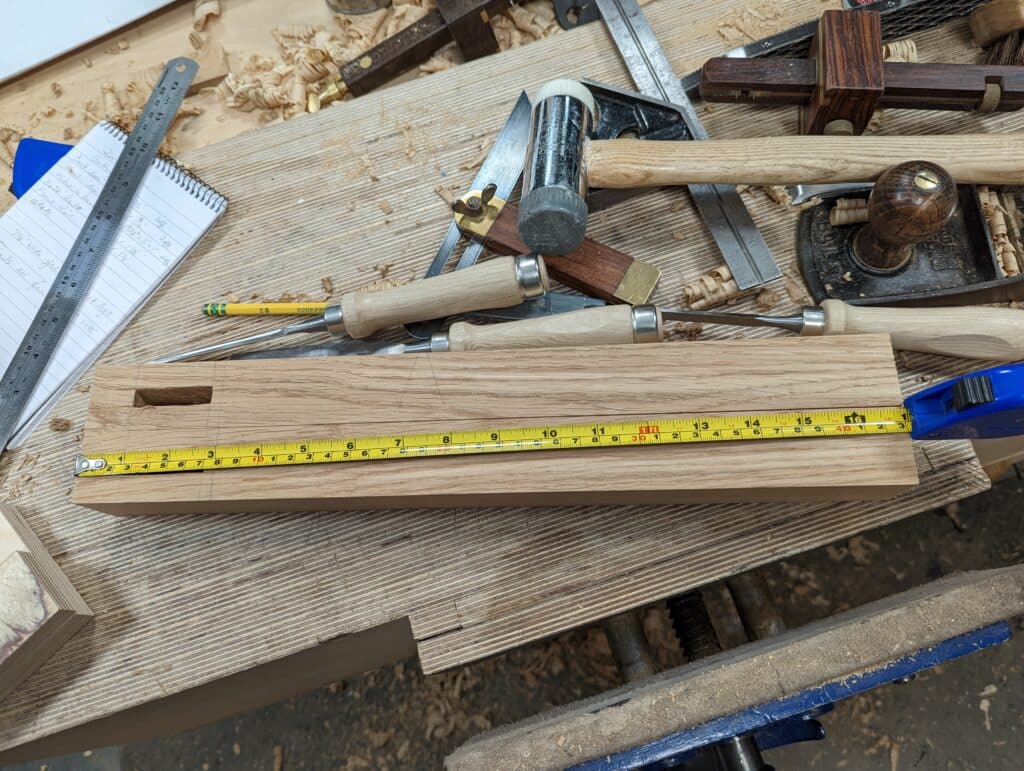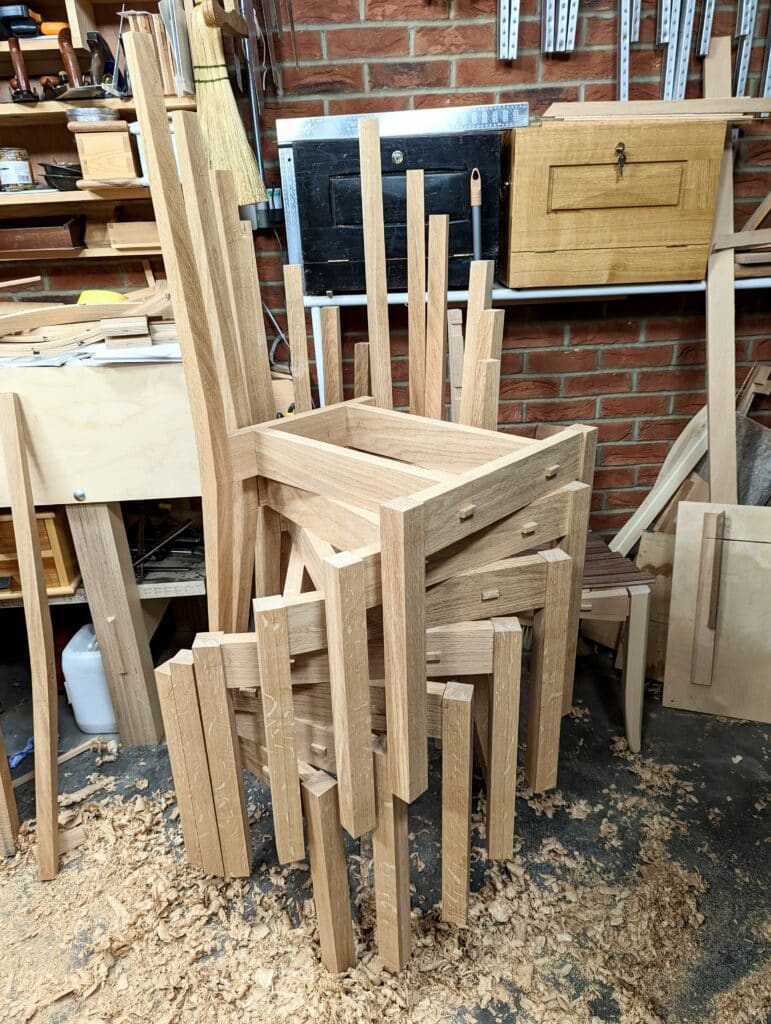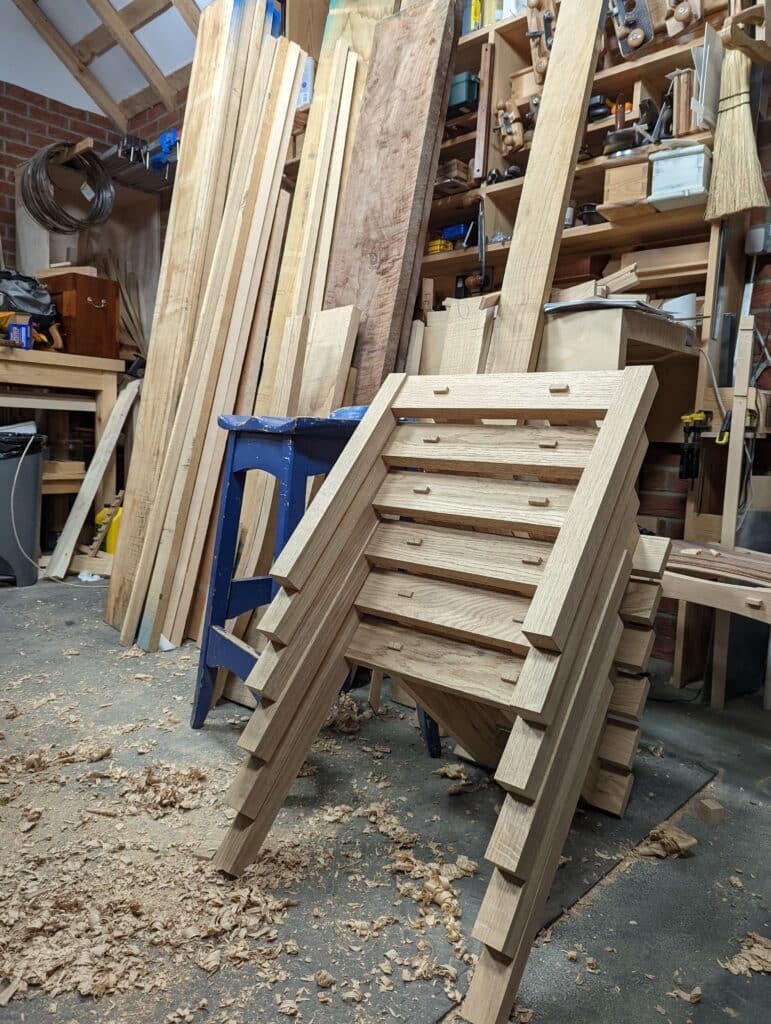My Chairs

My chairs emerged one by one in quick succession, but getting there to where the joinery flows is not usually easy. I started with two framing studs 1 1/2″ by 2 3/4″ and some sticks of wood 1/8″ thick by 1 1/4″ wide bent and superglued in place to an undisclosed bend. Some said I was trying to create a new trend but it was clay on the wheel nothing more: lightweight flexing of mind and matter; inspired stretching, an embracement of possibilities, enough to get me going further anticipating that a chair would soon, in a matter of minutes, stand on four legs. When it did, I felt, ‘OK’ a chair, good, but not good enough, and it wasn’t meant to be, it was a three-dimensional sketch that took thoughts into a placeholder. Here I am a couple of weeks later with a solid concept and several chairs underway. This is design!

It took me about 30 minutes to have this rough draft idea fleshed out, freestanding, and even suitable enough to very cautiously sit upon for a few minutes for me to think ‘height,’ ‘width,’ ‘depth,’ ‘angles’ and a few other things. From this point I developed the idea by altering my thinking, being willing to self-criticize, adjust my attitude, shorten, lengthen, raise lower the important elements until they fit me as a Mr. Average. Chairs are never made for tall or short people. Why? It doesn’t work, wouldn’t work, generally, I mean. People are conditioned to a seat at 17″ off the floor and no more than 18″ high unless it is a bar stool. Even if people have long legs or short ones, long torsos and so on, they are conditioned as soon as they can self-sit on a chair as a child to get used to this height. It wouldn’t work to have different heights of chairs in a cafe, a school, or in any institutional place and it’s the same for any home too. Conditioning is mostly about standardisation so simplicity in manufacture becomes readily guaranteed. Matching this, the chair height coincides with tables and you will find tables and desks rarely ever shift from somewhere between 28″ and 30″ max. Once a manufacturer sets up the manufacturing system, I’m talking IKEA for domestic supply and then Asian imports for cafes where a hundred chairs are made for chain cafes with 300 hundred outlets; think Starbucks worldwide and Costa on a UK domestic level. Go ahead, pop your tape measure in your backpack and do some measuring in your local cafes. Get heights and sizes into your head, you’ll find I am right. There really is not much flexibility when it comes to such things that I speak of and that is because of the impracticality of custom sizing to individuals and the reality that people of every height are conditioned from sitting age to adapt, adopt and accept the toleration of non-customised seat heights.

The human body is incredibly adaptable to many things. The problems that occur in posture are often unseen until the damage is done. The human body is incredibly adaptable to many things. The problems that occur in posture are often unseen until the damage is done. Take tapping on the computer keyboards as a professional in the early days before carpal tunnel syndrome became a recognised disease for people typing and using keyboards. I think it is a strange thing that after 57 years of minute-by-minute hammering with mallets and hammers I have no such damage to the disease associated with working at a keyboard. With thousands of heavy blows a day for me, you would think that to be the opposite, wouldn’t you? My many blogs on woodworking bench heights and opposing spurious theories supporting low bench heights is the result of my research and looking more deeply into workbenches and trying to understand why a bench height must be customised where long-term, continuous use is intended. More than that though, more important, is my working at workbenches all of my life and then working with 6,500 students at workbenches through the years, most people are very comfortable at a bench height of 38″. That’s because this suits the average height of men. Better to start high and make lower in half-inch increments over a few weeks wherever possible. Some things are fixed and some things are adaptable, you just have to know which.

Back to my chairs. Three iterations brought me to a confident design outcome. I didn’t refer to the reference manual I use from time to time where human proportions in use of pieces determine elements to designs such as tables and chairs. desks, kitchen counter heights and a thousand other useful details for designers. I used my own knowledge of almost six decades making and my own body to tell me what I needed to know. Such a thing is time-consuming, maybe two days of tweaking a prototype, but the long-term benefits will be that I have a comfortable chair that will last for decades if not even a century and more. The basic shape and the joinery is not fixed. But what intrigues me the most is that the chair design has eliminated many of the complexities associated with chair making where the joinery has many complex angles needing awkward shoulder lines with mitred tenons, twin rails, stretchers and so on. In my design, I have gone for good-sized tenons coupled with other features for combining resistance and strength. The end result is a comfortable design that is lightweight and attractive.


“design has eliminated many of the complexities”
I see no complexity with the front legs and four rails.
I guess housing and tenons are used like they are used for the back of the workbench drawer.
The challenge for me would be the rear legs and back rest.
Sylvain, Actually not the same as the drawer joint issue on the bench, more to it than that, but very interesting non the less. I think I can amaze you on the angled tenon shoulders and more still the angled mortise holes too. I just did all of the joinery on the frame of my seventh chair in 3 hours and fifteen minutes and that was taking my wood from the rough-sawn oak to the finished level by hand planing only, together with all of the hand cut joinery, so a pretty amazing step forward considering every joint is indeed actually hand cut.
Actually Paul, a measured drawing would be nice . . . 🤓
SUPPORT
🇺🇦
UKRAINE
Actually, no, I provide a full instructional on making the projects. This is a project I designed and am making for paying members of sellershome.com and woodworkingmasterclasses.com where the paying members pay to follow certain projects. They will get a pdf drawing as well as ten episodes detailing and demonstrating the whole process of making the design.
Just chiming in. Woodworkingmasterclasses is a bargain. If you’re serious about learning hand tools, the cost of membership is well worth it. You’ll learn a lot more from a single course than hours of scrounging the internet for information.
Thanks Paul.
-Richard
Hear, Hear
Always a good start if a new chair design doesn’t collapse when you first sit on it. The rest of the details can be altered to suit as needed. As for seat height, I have noticed in the last few year that lower seats are more difficult for me to stand up from. Most likely more an effect of advancing years than the seat design.
Those seem like good ‘visitor chairs’, for when you don’t want the older ones to stay too long. (eg. because the seat is flat). The Quakers had a lot of those.
Aside from that (seemingly) negative comment, I can only be impressed by the speed of their production and the quality of their build.
There are very few who can create in this way.
You see only the first iteration. The text is clear. I made three iterations before the final-cut version. The seat is nicely curved, shaped, tapered, fitted from front to back, laminated in oak and walnut for a contrasting look and then too for strength and the chair is extremely comfortable, lightweight but not too much; certainly not a ‘visitor chair‘, whatever that is? All in all, it fits the bill on every front. Speed is not the impressive aspect to this but the reality of how a good chair emerges from a paper page to rough-sawn boards and on to a chair in three-dimensional stability with the use primarily of hand tools like tenon saws, chisels, planes and a man’s hands. That was the point of me taking so much time out to write the article, really. Just to encourage others to think through processes from pencil to project. To compare this chair to the Quakers is quite unreal but intentionally demeaning I suppose.
The flat seat is only for the prototype.
We have not seen the final product yet.
I enjoyed reading your approach to the prototyping process. As a new woodworker, I need to give myself a break in thinking it should go from sketch to hardwood straight away and, instead, think in terms of construction 2×4’s!
As everything you make, it’s a beautiful design.
There’s just one thing I donät understand.
Is this design a bit weaker than a chair whith two rails jointed at each leg? I would think that you could twist the front legs in relation to the back legs and the front legs in relation to eachother.
Is this change in stability negligable?
Did you perhaps increase the thickness of the wood to compensate for it?
I also have a comment about carpal tunnel.
In my experience, people are more likely to get carpal tunnel problems if they
rely a lot on their computer mouse than if they mostly use the keyboard.
I would recommend anyone who uses a computer a lot to learn the ways of using the keyboard more. Almost everything you do on a computer can be done with the keyboard. Especially if you take the time to learn about carret browsing.
Off topic, but regarding the carpal tunnel & mouse problem, I have two oak desks, one a roll top probably built in the late ’80’s ( I bought it new in early ’94) and another oak desk probably built before WW II. Te point is they both have pull out shelves/arm rests which are very handy for not only writing but computer mouse usage as well. I have the old one as my computer desk and on my iMac I have the mouse sensitivity set as high as it will go. That means I can rest my forearm on the pullout, grip the mouse on the desk’s top between my thumb and the ring and little fingers and just pivot my hand and have the cursor go anywhere I wish on the 21″ screen. Never seem to have any wrist problems or discomfiture.
[No, I haven’t programed it to respond like the one on the original Star Trek: Kirk: “Computer.” Computer: “Working.”]
In the same vein as highly rating the masterclasses, it is always worth re-reading older post.
I once asked if the # 78 plane with its machined face could be used as a shoulder plane. The answer was in the post “REBATE PLANE #1—CONCLUDING THE #78 DUPLEX FILLETSTER PLANE” dated 31 May 2016 (which I was re-reading today for another reason):
“You can readily plane end grain as in shoulder lines and such too so don’t think you can’t because you can. If and when you do, it’s a good point to sharpen up the blade as this gives pristine results with the least resistance. ”
Knowing the price of shoulder planes and the price of a #78, this is also interesting on the budget point of view.
Just two sentences buried in an otherwise longer text.
Plenty of gems to be found.
I was taken by the varied ends of the bentwood slats on the back. Thought there could be a really stylish chair developing out of them by developing the variation.
I believe the slats will be trimmed later, could I be right, Paul?
Oh, this is such an exciting point in the whole! Today, I will be closing in on the conclusion of my dining chair as I did on my router plane which so thrilled me. These three-dimensional puzzles have come together throughout my life. Twelve years ago it was the completion of the two White House credenzas I designed for President Obama’s Inauguration that now stand in the Cabinet Room of the White House and I was standing inside the Cabinet Room. These recent additions mean as much to me as they did at that time. When I wrote my last book Essential Woodworking Hand Tools I was equally thrilled to hold that book in my hands for the first time when I watched the first 10,000 being printed at the printers.